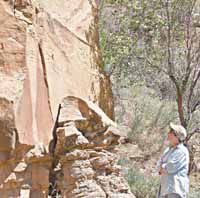| Donna Sacket, a representative from Senator Robert Bennett’s office, studies some rock art at Wilcox Ranch. |
On Wednesday morning, the parking lot at College of Eastern Utah Prehistoric Museum was filling with vehicles, some carrying media markings.
“For me, it was one of those last minute things,” said Reece Barrick, director of the museum. “I was informed that they may need to use the inside of the museum for the briefing this morning if the rain came down.”
But it wasn’t raining. In fact, the weather was cool and dry for the dozens of people who showed up from more than 31 media outlets including the NBC Today Show, National Public Radio, ABC News, USA Today, Fox News, the Washington Post and the Los Angeles Times among many others.
The reason for the largest national and state media fenzy in the Carbon County area since the Wilberg mine disaster in the 1980s was based on something much more positive.The reason is Utah’s revelation that archaeological gold has been discovered or, more explicitly, in the parcel of land known as the Wilcox Ranch in Range Creek.
The property was recently acquired by the Beehive State.
The ranch, which has been owned by the Wilcox family for over 50 years, was sold originally to the Trust for Public Land (TPL), a non-profit California preservation group in December of 2001.
The land that was purchased by the group straddles the Carbon and Emery County line. At that point the warranty deed also included several easements for some cattle crossings, oil company rights that had already been adopted and an easement for the Wilcox family to be able to remove personal property from the land through July 31, 2002.
The purchase of the property by the TPL brought about some private concerns by various county and local officials who were concerned about what the action meant. The TPL is often involved in buying property and placing conservation easements on it. TPL holds the property or gets other federal and state agencies to buy and administer the land. That is not always a bad thing. But in some cases, the easements restrict the prior uses and often affect future use
At the time of the purchase, TPL received a deed for a conservation easement on more than 999 acres of the land acquired set by a baseline survey on the property that was completed in August of 2001. The 18-page document restricts development of almost any kind within the range of its legitimacy and that the land “will be retained predominantly in its natural, forested, open space condition” and to “prevent any use of the property that will significantly impair or interfere with the conservation values of the property.”
Conservation easements are generally set up to protect specified lands “in perpetuity.” The provision means that, even when the land is sold to another individual, business or government agency, the easement still holds and cannot be violated.
| Bones, pieces of bones and skulls show where archeological sites undisturbed by modern man still exist in the lands purchased from the Wilcox family in 2001. |
While most of the easements of the type in question go back no more than 30 years, the guidelines have proven to be an effective way to control what happens on a piece of property, at least from the point of view of the parties who placed the easement.
In some parts of the county, a movement has been started to make it so easements have an ending point in time, such as the death of the owner or when land is sold, but groups in favor of the easements argue that the reason for them is to protect the land in the long term and not only during one caretaker’s life-span or ownership.
In 2003, the United States Congress approved allocating federal money to help Utah purchase the land from the TPL. Combined with funds from the Utah Quality Growth Commission and several sporting groups, the land was transferred to state ownership. At that a point a working committee consisting of a number of county, state and federal agencies was set up to study what to include in a management plan for the site.
Initially, the emphasis was on the wildlife and fisheries in the area, and to a large extent it still is. The area is full of wild turkeys, hawks, eagles, cougars, elk and deer. The stream could also become an important fishery. The conservation easement will be managed by the Utah State Division of Wildlife Resources (DWR).
But the discovery by state archeologists of what is estimated to be 2,000 to 5,000 undisturbed sites has fueled the imagination of people across the country and consequently led to the large influx of outside news sources seeking information. The fact that archaeologists and others are reporting sites that have not been touched by modern man also has caught the interest of many in the media because those kinds of places barely exist in the North American continent anymore.
The land is located about 35 miles east of Price and straddles Range Creek. Of the nearly 5,000 acres, about one-third lies along the creek. The rest is on surrounding highlands.
As the media began to tour the site on Wednesday morning, the crowd of reporters and others had grown larger than anyone expected. Initial lists from the media tour DWR was putting together showed only about 14 outlets committed with a couple of dozen people involved.
Reports from Range Creek indicated that, by 9:30 a.m. on Wednesday, there were nearly 200 people, with many more news outlets covering the story than had been predicted.

